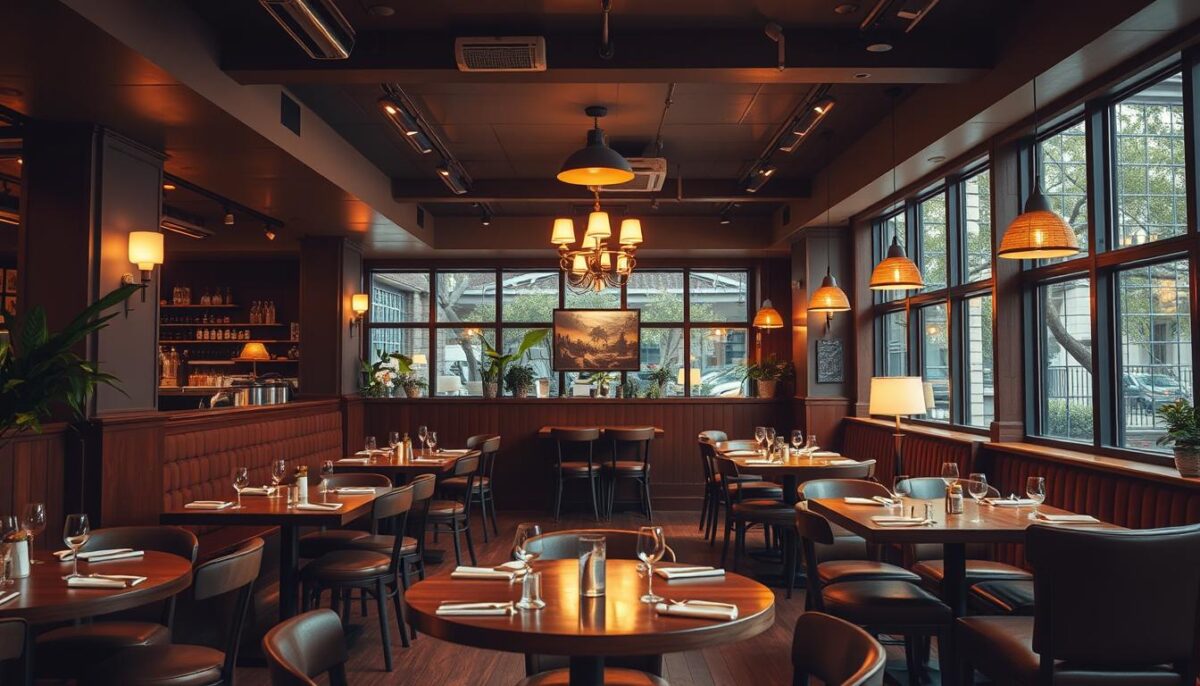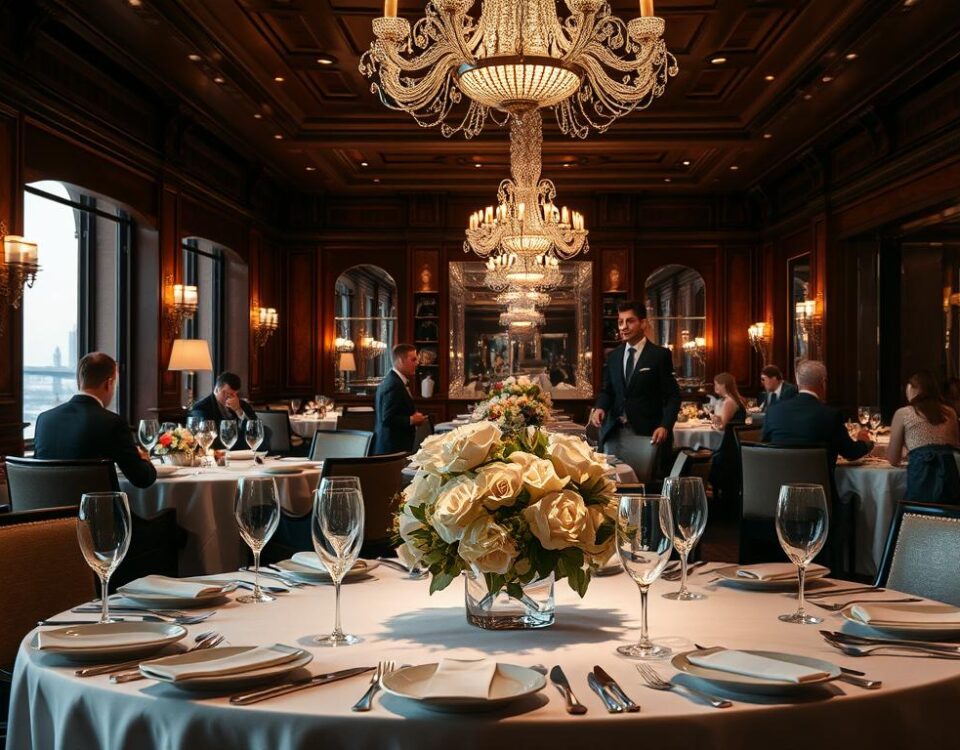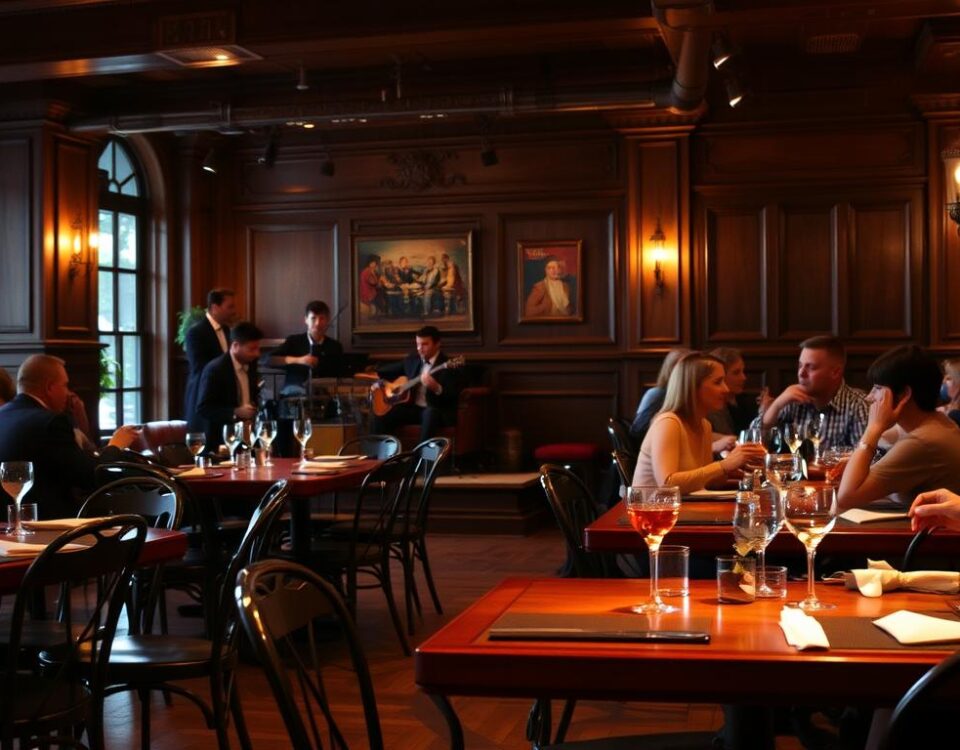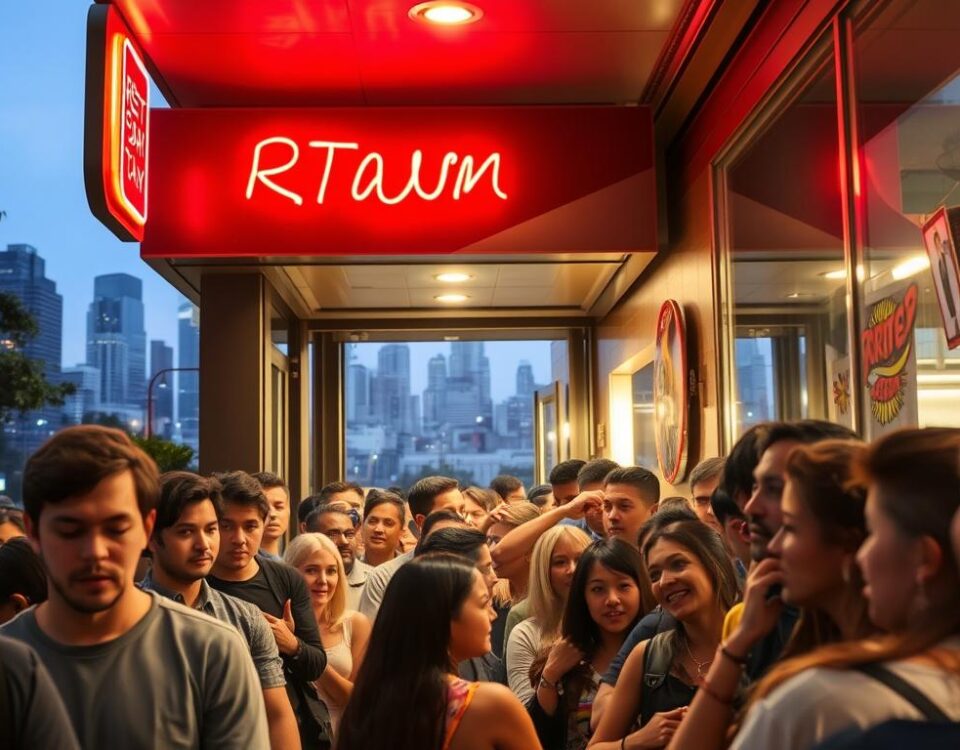
Restaurant Line Psychology: How to Attract More Customers with Perceived Popularity
October 31, 2025
Boost Restaurant Sales with Music and Lighting: What Science Says Works
October 31, 2025I still remember walking into a quaint little Italian restaurant in the heart of the city, where the aroma of freshly baked bread and the soft glow of candlelight instantly made me feel at home. It wasn’t just the taste of the food that left a lasting impression, but the entire dining experience that made me a loyal customer.
Did you know that a well-crafted dining atmosphere can increase customer loyalty by up to 25%? In today’s competitive landscape, it’s not just about serving great food; it’s about creating an immersive experience that keeps customers coming back.
As I guide you through the essential elements of restaurant experience design, you’ll discover how to transform your establishment into a destination that earns 5-star reviews and fosters a loyal customer base. What if you could create a memorable experience that sets your restaurant apart from the rest?
Key Takeaways
- Crafting a holistic and engaging dining experience is crucial for customer loyalty.
- The ambiance, service, and food presentation all play a significant role in shaping the customer’s experience.
- Understanding the psychology behind memorable dining experiences can help you create a loyal customer base.
- Effective restaurant interior design can elevate the overall dining experience.
- A well-designed dining experience can lead to increased customer loyalty and 5-star reviews.
The Psychology Behind Memorable Restaurant Experiences
Understanding the psychology behind memorable restaurant experiences is crucial for creating a dining environment that fosters loyalty and encourages positive reviews. Creating an experience that resonates with customers involves more than just serving great food; it’s about crafting an atmosphere that makes diners feel valued and understood.
Factors Influencing 5-Star Reviews
Several factors contribute to diners leaving 5-star reviews. Exceptional service and attention to detail are crucial. Customers also appreciate when their preferences are recognized and remembered. The overall ambiance and comfort of the restaurant play a significant role in shaping their experience.
| Factor | Impact on Review |
|---|---|
| Exceptional Service | Positive |
| Ambiance | Positive |
| Attention to Detail | Positive |
Why Customers Return
Customers return to restaurants that provide a consistent experience. The emotional connection they form with the establishment is a strong predictor of loyalty. Factors such as recognition, value perception, and signature items or experiences also influence repeat visits.
- Consistency in quality and service
- Emotional connection and sense of belonging
- Recognition and personalized service
By understanding these psychological factors, restaurateurs can create a brand identity that resonates with their target audience, fostering loyalty and encouraging repeat visits.
Crafting Your Restaurant’s Unique Concept and Theme
To create a lasting impression, restaurants must develop a distinct concept that resonates with their target audience. This involves more than just serving good food; it’s about creating an immersive experience that aligns with the restaurant’s brand and appeals to its intended customers.
Aligning Your Concept with Your Target Audience
Understanding your target audience is crucial in developing a concept that resonates with them. I analyze demographics, preferences, and dining habits to create a concept that meets their needs and exceeds their expectations. By doing so, restaurants can establish a loyal customer base.
Creating a Cohesive Brand Identity
A cohesive brand identity is vital for a restaurant’s success. This involves developing a consistent visual brand, tone, and message that reflects the restaurant’s concept and appeals to its target audience. Consistency is key to building a strong brand identity that customers can recognize and trust.
Examples of Successful Restaurant Concepts
Several restaurants have successfully implemented unique concepts that have contributed to their success. For instance:
- Noma in Copenhagen exemplifies concept-driven design with its New Nordic philosophy.
- The Coffin Bar in Lancaster, PA, demonstrates the power of a bold, distinctive theme.
- Ultraviolet in Shanghai showcases technology-enhanced dining with projection mapping and sensory elements.
| Restaurant | Concept | Key Features |
|---|---|---|
| Noma | New Nordic | Local ingredients, foraging, seasonal menus |
| The Coffin Bar | Gothic aesthetics | Unique cocktails, immersive atmosphere |
| Ultraviolet | Technology-enhanced dining | Projection mapping, sensory elements |

By examining these examples and understanding the importance of aligning a concept with its target audience and creating a cohesive brand identity, restaurants can develop a unique concept that sets them apart in the competitive dining landscape.
Designing the Physical Space for Optimal Flow and Comfort
Designing a restaurant’s physical space is not just about aesthetics; it’s about creating an environment that fosters comfort and flow. A well-designed restaurant can significantly enhance customer satisfaction and encourage repeat visits.
Strategic Layout Planning for Different Dining Styles
A strategic layout is crucial for accommodating different dining styles, from intimate dates to large group gatherings. By creating distinct areas within the restaurant, you can cater to various customer needs while maintaining an overall cohesive design.
Creating Comfortable Seating Arrangements
Comfortable seating is essential for a positive dining experience. This includes not only the chairs and tables but also the overall layout that allows for easy movement and conversation. Ergonomic seating and adequate spacing can make a significant difference in customer comfort.
The Often-Overlooked Importance of Restroom Design
Restroom design is a critical aspect of restaurant interior design. Restrooms should be clean, visually appealing, and well-maintained. Factors such as lighting, color schemes, and premium materials can elevate the restroom’s aesthetic. Moreover, cleanliness protocols and accessibility features are crucial for guest comfort.
| Design Element | Importance | Impact on Customer Experience |
|---|---|---|
| Restroom Cleanliness | High | Significantly affects overall perception of the restaurant |
| Comfortable Seating | High | Directly influences customer satisfaction and repeat visits |
| Strategic Layout | High | Enhances flow and accommodates different dining styles |
Sensory Elements of Restaurant Experience Design
To craft a memorable dining experience, restaurants must consider various sensory elements that influence customer behavior and satisfaction.

Lighting Psychology: Setting the Perfect Mood
Lighting can significantly impact the ambiance of a restaurant, influencing the overall dining experience. Warm lighting can create a cozy atmosphere, while bright lights can make a space feel more energetic.
The Power of Color in Dining Spaces
The choice of color in a restaurant can evoke different emotions and impact appetite and productivity. Warm and muted colors like terracotta and Tuscan yellow can create a cheerful and inviting ambiance. Green is a trendy choice that promotes freshness and health, making it suitable for upscale establishments.
Sound Design: Music and Acoustics That Enhance Dining
Sound is a crucial yet often overlooked element in restaurant design. It directly impacts conversation ease, dining pace, and overall comfort. Strategic music selection and acoustic treatments can enhance the experience and create a memorable atmosphere.
By incorporating these sensory elements, restaurants can create a unique and memorable dining experience that fosters customer loyalty and drives repeat business.
Elevating the Dining Experience Through Service Excellence
Exceptional service is the backbone of a successful restaurant, elevating the dining experience and fostering customer loyalty. To achieve this, it’s crucial to focus on the human element of the service.
Training Staff to Create Memorable Interactions
Training staff to deliver personalized and attentive service is vital. I recommend empowering staff to make decisions that create authentic experiences for customers. This can be achieved through comprehensive training programs that emphasize the importance of recognizing and responding to customer needs. Effective training enables staff to craft memorable interactions that leave a lasting impression on customers.
- Staff empowerment allows for in-the-moment personalization, creating unique experiences.
- Comprehensive training programs ensure staff are equipped to deliver exceptional service.
Personalizing Service for Repeat Customers
Personalizing service for repeat customers is key to building loyalty. By implementing systems for identifying return guests and tracking their preferences, restaurants can create “surprise and delight” moments. I believe that genuine interest in customers’ lives and experiences outside the restaurant creates deeper connections than transactional recognition. This approach requires a balance between data utilization and intuition to avoid coming across as overly automated or casual.
- Recognition systems should be accessible to all customer-facing staff to facilitate personalized service.
- Preference tracking enables restaurants to surprise and delight repeat customers.
By focusing on service excellence and personalizing the experience for customers, restaurants can significantly enhance the overall dining experience, leading to increased customer loyalty and positive reviews.
Creating Signature Moments That Guests Will Remember
Creating unforgettable experiences is the holy grail of restaurant design. To achieve this, restaurants must focus on crafting signature moments that leave a lasting impression on their guests. These moments can be the difference between a good dining experience and a great one.
Developing Instagram-Worthy Design Elements
One way to create signature moments is by incorporating Instagram-worthy design elements. This can include unique architectural features, visually appealing decor, or interactive installations that encourage guests to share their experience on social media.

Incorporating Local Art and Community Connections
Incorporating local art and community connections is another effective way to create memorable moments. By showcasing local artwork or hosting community events, restaurants can foster a sense of belonging and connection with their guests. As I always say, “Artwork adds a personal touch to your restaurant interior design and can help create a unique and memorable experience.”
Crafting Unique Rituals and Traditions
Crafting unique rituals and traditions can also help create signature moments. This can include daily, weekly, or seasonal events that guests look forward to and participate in. Some effective strategies include tableside preparations, special toasts, or communal moments that become signature elements of the dining experience.
| Rituals | Description | Benefits |
|---|---|---|
| Tableside Preparations | Preparing dishes at the table | Interactive, engaging |
| Special Toasts | Raising a glass to celebrate | Creates communal moments |
| Communal Moments | Sharing food or experiences | Fosters connection among guests |
“The most powerful restaurant traditions often connect to deeper cultural practices or universal human experiences that resonate emotionally.”
Technology Integration for Modern Restaurant Experiences
To stay competitive, restaurants are leveraging technology to create a more personalized and efficient dining experience. The key is to strike a balance between technological efficiency and genuine human connection.
Digital Tools That Enhance Rather Than Distract
Digital tools can significantly enhance the restaurant experience when used thoughtfully. For instance, mobile apps for ordering and payment can streamline service, reducing wait times and allowing staff to focus on hospitality. Some effective digital tools include:
- Mobile ordering and payment systems
- Digital menus that can be easily updated
- Reservation systems that manage waitlists efficiently
These tools free staff from transactional tasks, enabling them to concentrate on building relationships with customers.

Balancing High-Tech and High-Touch Service
While technology can enhance the service provided by a restaurant, it’s crucial to maintain a balance between high-tech solutions and high-touch, personal interactions. Staff training should emphasize smooth transitions between tech-enabled and personal service modes. This balance ensures that the restaurant remains welcoming and personalized.
By integrating technology thoughtfully, restaurants can create a seamless and enjoyable dining experience that meets the expectations of modern customers.
Conclusion: Bringing It All Together for 5-Star Success
A well-designed restaurant experience is the foundation for earning 5-star reviews and fostering repeat visits. Throughout this article, I’ve shared numerous strategies for creating a memorable dining experience. The true key to 5-star success lies in how these elements work together to create a cohesive, memorable experience.
To achieve this, restaurants must maintain a clear vision while continuously refining their execution based on guest feedback and operational insights. Staff engagement in your vision is crucial—when your team believes in and is excited about the experience they’re creating, guests feel that enthusiasm. Regular experience audits can help evaluate your restaurant through the eyes of first-time and returning guests.
Remember, the ultimate goal isn’t just to get 5-star reviews but to create experiences worthy of them. Focus on the guest experience, and the ratings will follow. By balancing consistency with innovation and staying true to your unique vision and values, you can create a lasting impression that keeps guests coming back.
By implementing these strategies and maintaining a focus on restaurant experience design and restaurant interior design, you can create a truly exceptional dining experience that earns 5-star reviews and fosters loyalty.
FAQ
What makes a fine dining atmosphere memorable?
A fine dining atmosphere is memorable when it combines elegant ambiance, exceptional service, and attention to detail, creating a lasting impression on customers.
How do I create a cohesive brand identity for my dining establishment?
To create a cohesive brand identity, I focus on developing a unique concept that aligns with my target audience, and then consistently apply this identity across all elements, including interior aesthetics, menu, and service style.
What role does lighting play in enhancing the dining experience?
Lighting plays a crucial role in setting the mood and atmosphere of a dining space, and can greatly impact the overall dining experience. I consider factors like brightness, color temperature, and fixture style to create a welcoming ambiance.
How can I make my restaurant’s physical space more comfortable for customers?
To create a comfortable physical space, I prioritize layout planning, ensuring that the flow of the space is logical and unobstructed, and that seating arrangements are cozy and inviting.
What are some effective ways to incorporate local art and community connections into my restaurant’s concept?
I like to incorporate local art and community connections by featuring local artists’ work, sourcing ingredients from nearby suppliers, and hosting events that celebrate the local culture, which helps to create a sense of community and brand identity.
How can technology enhance the dining experience without distracting from it?
I believe that technology can enhance the dining experience when used thoughtfully, such as through digital tools that streamline service or provide interactive menu experiences, while still maintaining a high-touch service approach.



